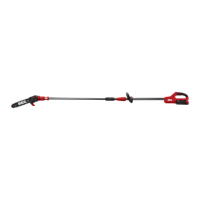23
Chain Maintenance
WARNING
Remove the battery pack before performing any maintenance. Failure
to heed this warning could result in serious personal injury.
WARNING
Always wear gloves when handling the saw chain. These components
are sharp and may contain burrs.
Use only low-kickback chains on this saw. This fast cutting chain will provide kickback
reduction when properly maintained.
A properly sharpened saw chain cuts through wood effortlessly, even with very little pressure.
Never use a dull or damaged saw chain. A dull saw chain cutter leads to increased physical
strain, increased vibration load, unsatisfactory cutting results and increased wear.
For smooth and fast cutting, the chain needs to be maintained properly. The chain requires
sharpening when the wood chips are small and powdery, the chain must be forced through the
wood during cutting, or the chain cuts to one side. During maintenance of your chain, consider
the following:
•
Improper ling angle of the side plate can increase the risk of a severe kickback.
•
Raker (depth gauge) clearance. Too low increases the potential for kickback. Not low
enough decreases cutting ability.
•
If cutter teeth have hit hard objects, such as nails and stones, or have been abraded by mud
or sand on the wood, have the chain sharpened by a qualied service technician.
NOTICE:
Inspect the drive sprocket for wear or damage when replacing the chain. If signs
of wear or damage are present in the areas indicated, have the drive sprocket replaced by
qualied service technician.
How to Sharpen the Cutters
Be careful to le all cutters (Fig. 18) to the
specied angles and to the same length, as
fast cutting can be obtained only when all
cutters are uniform.
1. Remove the battery pack. Wear gloves for
protection.
2. Properly tension the chain prior to
sharpening. Refer to the section:
“
Adjusting the Chain Tension
” earlier in
this manual.
3. Use a 5/32” (4.0 mm) diameter round le
and holder (available separately). Do all
of your ling at the middle position of the
guide bar.
4. Keep the le level with the top plate of the tooth. Do not let the le dip or rock.
Fig.18
Top Plate
Side Plate
Depth Gauge

